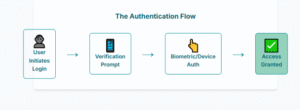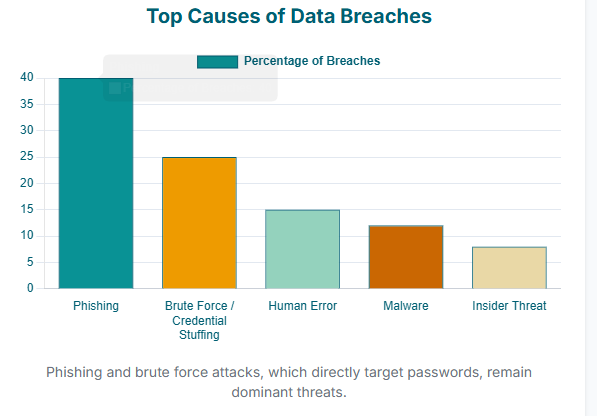Password Challenge
For decades, passwords have been the standard for security, but they’ve become a major source of frustration and a primary target for cyberattacks. This trend continues to be a problem of data breaches. Most data breaches are caused by weak or stolen credentials. Can the future be password less authentication?
What is Passwordless Authentication?
Passwordless authentication replaces traditional passwords with more secure and user-friendly methods. Instead of relying on something you know (a password), it verifies your identity based on something you have (like a phone) or something you are (like your fingerprint).

Passwordless Methods on the Rise
Passwordless authentication is a rapidly growing trend in the cybersecurity space. Users are demanding faster, frictionless ways to authenticate without remembering complex passwords. This trend is driving companies like Meta (Facebook) to introduce passkeys as a passwordless login option for their platforms. Various industries, including the chip design sector, are exploring passwordless authentication solutions to enhance security in critical environments. It has the ability to protect users from phishing, malware, and other attacks by leveraging on-device authentication like Face ID or Touch ID. There are several leading passwordless authentication methods that are gaining traction in the industry. Here are some of the most common ones:
- Biometrics: Biometrics authentication verifies your identity using unique physical traits like fingerprint scanners, facial or iris recognition directly on your device. It relies on unique physical characteristics, making it difficult to replicate or spoof. It is fast, intuitive, and highly secure.
- Security Keys: These are physical devices, such as USB or NFC-enabled security keys, that users can connect to their devices for authentication. They provide strong security by generating and storing encryption keys locally.
- One-Time Passcodes (OTPs): OTPs are temporary codes sent to a user’s phone or email that they can use to log in to a website or application. They provide an extra layer of security as they are valid for only a short period of time.
- Push Notifications: Users can authenticate by responding to push notifications sent to their smartphones or other devices. This method is more secure than OTPs as it requires interaction with the user’s device.
- Email Magic Links: Instead of passwords, users can log in to a website or application by clicking on a unique link sent to their email address. While more secure than static passwords, they are more susceptible to interception.
FIDO
The FIDO (Fast Identity Online) Alliance is a consortium of leading technology companies, service providers, and financial institutions, such as Google, Microsoft, Visa, and Mastercard with a common goal of reducing the world’s reliance on passwords by developing and promoting open, interoperable authentication standards. FIDO is an important and a leading passwordless authentication method that uses public-key cryptography to provide strong authentication without the need for passwords. It includes standards like FIDO2 and Universal Second Factor (U2F) that enable passwordless authentication using security keys, biometrics, and other forms of strong authentication.
Some of the benefits of FIDO authentication include:
Enhanced Security: FIDO authentication uses strong cryptography to provide secure, phishing-resistant authentication that is not vulnerable to replay attacks.
Ease of Use: Users can authenticate with a simple tap of a security key or fingerprint, making the process seamless and user-friendly.
Interoperability: FIDO standards are widely adopted and supported by major browsers, operating systems, and service providers, allowing for easy integration.
Privacy-Preserving: FIDO authentication does not rely on shared secrets, and biometric information never leaves the user’s device, ensuring user privacy.
FIDO2 is currently the gold standard, but this can change due the way technology is rapidly evolving. It incorporates the Web Authentication (WebAuthn) standard developed in collaboration with the World Wide Web Consortium (W3C). FIDO2 belongs in the Security Keys category and uses a physical security key or device (like a phone) to create unique cryptographic keys for each site, making phishing nearly impossible. It is considered to be more secure than the traditional password.
Benefits of Going Passwordless
Reduction in Phishing Attacks: By removing the password, you remove the primary target of phishing campaigns.
Faster Login Times: Users get in faster, thereby improving user experience and this increases conversion rates.
Fewer Support Tickets: Eliminating password reset requests significantly cuts down on help desk costs.
The Path to Adoption
Assess & Plan
Identify critical applications and user flows. Choose the right passwordless methods for your audience.
Implement & Integrate
Integrate passwordless solutions into your existing identity providers and applications.
Onboard & Educate Users
Guide users through a simple, one-time setup to register their device or biometric factor.
Deprecate Passwords
Gradually phase out passwords, moving towards a fully passwordless environment for maximum security and UX benefits.
As passwordless authentication continues to gain traction, organizations and users alike can benefit from increased security, convenience, and privacy in the digital world.
Hashtags
#PasswordlessAuthentication #FIDO2 #WebAuthn #IdentityAndAccessManagement #GoPasswordless #IAM



